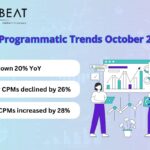
Want to know how much you could benefit from Ad Refresh? Use our calculator to find out!
What are Video ads?
- Video ads are a type of online advertising that uses the video content to promote products, services, or brands. In general they can appear on various platforms like websites, social media, streaming services, and even mobile apps.
- Video is a captivating format that can grab user attention more effectively compared to static images or text-based ads. Video motion, sound, and storytelling capabilities allow video ads to convey information in a better way.
Types of Video ads:

1) Outstream ads:
An outstream video ad is an ad unit displayed on display ad slots of publishers’ websites, typically inserted between paragraphs of text, and is served outside of a traditional video player. It is called outstream because the video does not require existing video content to be present.
- These video ads appear outside of video players, often on websites or apps, and can take various formats like pop-ups or autoplay ads and can float on the page.
- Outstream ads won’t need any video player integration or video content, they can serve video as in a regular display ad slot.
- These ad formats will have lower CPMs when compared to instream ads.
- Even if the user doesn’t click on the player, it will just play in their respective positions, no matter what.
DataBeat’s Optimization Calculator empowers publishers to estimate the potential revenue boost from incorporating Outstream ads on their websites. Through an in-depth analysis of key performance metrics, the calculator provides publishers with a clear visualization of the incremental revenue achievable with Outstream video advertising.
2) Instream ads:
- These ads will serve in between the actual video content. We need an embedded video player with video content to serve instream ads.
- In general, instream ads will have higher CPMs and viewability because of its precise targeting options allow advertisers to reach relevant audiences within their area of interest with a greater user engagement.
According to IAB, an instream video ad is an ad that is played before, during or after the streaming content that the consumer has requested (once the consumer wants to watch the video – he clicks. Then pre roll, mid roll, and post roll.
So, it’s only an instream video ad if a user clicks/ action that user took, to play the video. To be considered as an instream video ad, (pre roll, mid roll, and post roll placements) video placements/impressions must be set to “SOUND ON” by default at start.
Top Outstream Video player providers:
We have different video player providers in the market and some of them are given below:
- Primis
- Connatix
- Avantis
- Vidazoo
- JW player
Outstream Video ads in detail:
Outstream video advertising enables marketers to place video ads outside of traditional video players, such as in articles, social feeds, and mobile apps.
In the past, video ads could only be used with existing video content, which posed a limitation for publishers without such content. Outstream videos overcome this limitation by allowing publishers to display video ads within their text-based content. But now, a publisher’s website doesn’t need to have video content to display ads. Advertisers can insert their video ads within the text or images of a web page or app, creating an organic appearance outside of a video player.
Typically, an outstream video ad remains hidden until the user scrolls to a certain point on the page. At that point, the video will autoplay but will pause if the user continues to scroll. If the user opts to engage with the ad, they can tap to activate sound or expand it into a full video player.
IAB Guidelines, 2022:
- According to IAB, Out-stream video ads are usually served alone with their own player in a display placement.
- Example: A video that plays in the middle of an article or a video that stays at the bottom (left/right) of the page or floats as you scroll down to read the article
- When player loads with default ‘SOUND OFF’ must be indicated as out-stream placements in OpenRTB.
Types of Outstream Video ads:
There are 3 different types of Outstream Video ads namely:
- In-banner video ads
- In-page video ads
- In-feed/ In-text video ads

How to set up Out-stream video ads?
Out-stream video ads can be served via dynamic allocation and are also available with Open Auction, Preferred Deals, Private Auctions, and Programmatic Guaranteed.
Dynamic allocation requirements:
Line item Level:
- Ad type: The “Display” line item must be used
- Expected creatives: A display size must be targeted in the line item (for example, 300×250).
- Ad Manager looks at all sizes to determine eligibility of non-in-stream/ Out-stream video and uses the largest of the eligible for rendering (based on aspect ratio and minimum height and width).
Private Auction requirements:
- Inventory type: Must be set as “Display”, as the Inventory type value.
Programmatic Guaranteed and Preferred Deals requirements:
Proposal line item Level :
- Add targeting: Must choose “Display” or “Mobile app” as the Inventory type value.
Line item Level:
- Ad type: The “Video or audio” ad type must be used
- Expected creatives: The line item must specify a video creative size (for example, 300x250v), and the display equivalent of that size (300×250) must be present in requests coming from targeted inventory to be eligible.
- Ad Manager uses the largest of the eligible sizes for rendering (based on aspect ratio and minimum height and width).
Difference between Out-stream and In-stream video ads:
| Features | Out-stream video ads | In-stream video ads |
|---|---|---|
| Placement | Oustream video ads are placed in non-video environments such as, social media feed, between articles or apps | ads appear before, during, or after video content users watch |
| Video Player | No video player is required on a publisher’s site | Video player is required on a publisher site |
| Sound | Autoplay without sound by default | Autoplay with sound by default at start |
| User’s control | Even if player started to show ads, user can scroll through or can close the player | Sometimes, Ads play before the user gets a chance to skip through them and some are skippable |
| Dimensions of player | Can be customized to different sizes | There are standard requirements for video player |
| Viewability | Less compared to In-stream due to more user control | Viewability is high because user will be in the viewport |
| Completion rate | Have low completion rate | Typically have higher completion rate |
| User experience | Less intrusive because it is not placed within the video stream | As these ads are in between the stream, user might feel disruptive due to long/ non skippable/ frequently occurring ads |
Advantages:
- Does Not Require a Video Player: This Outstream doesn’t require a designated video player and doesn’t depend on existing video content, which enables many publishers to monetize and explore this type of format.
- Less interruptive: Autoplay begins with default sound off and pauses when out of view
- Resumes from the pause point when the user scrolls back up
- Replay button available after the video completes
- Good User Experience: Due to its non – intrusive or non – interruptive format, will preserve and enhance user experience.
- Flexibility: As Outstream Video ads are easier to implement compared to other video ad types, they are more flexible. They don’t require special equipment like video players as they can be shown in the display slots.
- Increased viewability & eCPMs: Ads will play only when the user is in the viewport, which ensures 100% viewability and higher eCPMs for publishers. Some effective implementations are Sticky ad units (floating mini players) that stay on the user’s screen while they browse.
- Reach: Easy to integrate with most advertising platforms, like Google Ad Exchange.
- Track Reporting: With metrics like Viewability, Completion rate, and engagement rate we can track the performance of Oustream video ads. The insights from these reports can be used to optimize future campaigns for better yield.
Disadvantages:
- Ad Visibility: Outstream ads tend to have lower visibility compared to instream video ads, as users might not always notice or engage with them.
- Ad Blocking: Users with ad-blockers may prevent outstream video ads from being displayed.
- Ad Placement: Poorly placed outstream video ads can cause accidental clicks or frustrate users, resulting in negative brand perception.
How can DataBeat help in this area?
DataBeat can be helpful in setting up video players on page in terms of both In-stream and Out-stream, and helps to monitor the KPIs which are crucial for Video performance. Databeat can be a major advantage for publishers due to video troubleshooting techniques.










